Climatic change is the natural condition, while summer means the heat stress occur from March to June. In humans, summer stress gives some seasonal holidays but what about the animal that to in rural areas, some of the facts occur during summer in animals. Animal will also undergoes heat stress during summer. During summer especially in rural areas due to scarcity of food and water, animals suffer a lot and reduced in milk production as well as reproduction, sometimes due to sever heat stress death will be occur.
Heat stress is the environment condition where increased climatic temperature and causes stress to the humans as well as animals. This inducing thermoregulatory changes in the cattle, buffaloes, sheep, goats, dog and horses. The hot, humid and dry conditions make the body of the animal to thermoregulatory process and heat dissipation occurs by panting and sweating. During extreme hot weather, the animal undergoes heat stress.
In India, rural people always prefer for grazing the animals in hilly area due to lack of land, fodder, water. The Indian desi breed are thermo-tolerant and adopt to the change in the climatic conditions. But the cross breeds, exotic breed are more prone for the heat stress. While buffaloes also more susceptible to the heat due to the skin coat absorbs more solar radiation and fewer sweat glands owing of this fact the heat dissipation not occur properly and causes for summer stress in the buffaloes. The horses having more sweating pore and dogs does the panting so heat stress is less in dogs and horses.
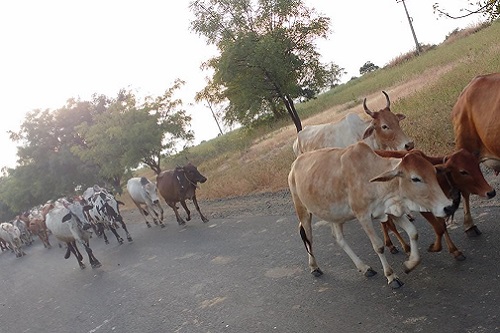
After change of climate from winter to summer animals will suffer from stress and come down with disease. As the temperature increases in summer there will be lot of changes on animals health and reproduction. In summer due to heat stress there will be severe, fall in milk production. As the temperature increases animal will try to adopt for the temperature but after a point animals not able to cope up heat zone leading to heat stress. The diseases like foot and mouth disease, ephemeral fever and PPR in small ruminants diseases outbreak observed in summer. Indigenous animals are heat tolerant compared to cross bred or pure bred cattle Young and old animals will suffer more due to poor heat regulation mechanism.
Buffaloes are more prone for heat stress during summer
Stressful condition
- The animals are more prone during March to June in southern part and April to June in East, west and northern part of India.
- The animals with lack of water and fodder facilities.
- The timing of grazing like from 11 am to 4pm is the hot and solar radiation is more so animals directly goes heat stroke sometimes.
- The buffaloes are more prone while grazing in the summer.
Symptoms of heat stress in the animals
- Rapid and weak pulse
- Elevation in the heart rate, respiration rate and rectal temperature, shallow and rapid breathing.
- During heat stroke, the body temperature raise up to 106-108°F, the cattle and buffaloes goes with unconscious, dizziness, dry body condition.
- Skin become dull, eyeball sunken, unusual salivation, animals may fallen down suddenly due to dehydration.
Signs of heat stress in different animals
- Cattle: increase salivation. Decreased digestibility of feed increased water consumption- reduce in feed consumption, hurried respiration, fall in milk yield in female animals, dehydration diarrheal due to heat stress and passing concentrated urine. Increase body temperature, animals respiration hurried and panting and preferred to move towards the shade and will try to eat more green fodder. High incidence of abortion and early embryonic death. Tick infestation will be peak in summer causing high incidence of haemoprotozoal diseases like babesiosis and theileria.
- Calve: are mote susceptible to heat stress and dehydration leading to sudden death without any apparent lesions.
- Horses: profuse or no sweating observed, panting (>20breaths/min), rapid heart rate, dry and hot skin coat, High rectal temperature and sever dehydration.
- Sheep and goats: they will not graze in afternoon hours and preferred to tree shades, consume less feed and more water. There will be less gain in body weight and due to sunstroke causes diarrhoea and passes concentrate urine. Weight gain will be very poor.
- Dogs: more prone to heat stress causes excessive panting, reddish eyes, drooling of saliva, dehydration, fever, lack of urine, rapid pulse rate, respiratory rate and muscle tremors are the signs showing during heat stress.
- Cat: Panting, distress breathing, fever, diarrhoea and vomiting, reddish tongue, restlessness and increased salivation.
Indirect effect of heat stress in animals
Sub-clinical ruminal acidosis and fall in the bi-carbonate level in the blood, drop in concentrate due to increased in corticosteroid hormone level in the blood. Blood flow to skin increase and decrease to internal organs and reduced weight gain. Weakness, loss of draught power in bullocks, less libido in bullocks, lower reproduction of the females due to early embryonic death occurs. Fall in production and death occurs in severe cases. Fall S.NT. fat and quantity of milk in lactating animals. Animals will be in stress and prone for the infection. Poor digestibility of feed leads to poor performance of animals.
First aid during heat stress or Sun stroke
Animals which are affected by sun stroke, immediately shift to the animals under the shades like tree or animal shed. It should be wrapped either wet clothes and give to pure drinking water along with electrolyte. After that immediately concern to Veterinarian for further treatment.
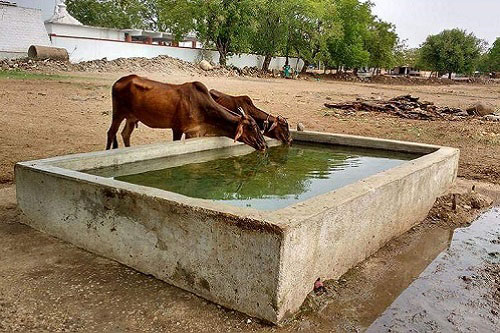
Management of summer stress
- The animals kept under the shed. The sheds are covered with tree or roof painted with white painting.
- Grazing of animals should be done morning 6- 10 am and in evening from 5-7pm so that direct exposure to sunlight should be avoided In peak hours
- Provide clean fresh ample drinking water to animals all the time of the day.
- Proper ventilation should be adjusted in the animal shed.
- Fans and foggers should be available in the afternoon hours.
- For buffalos wallowing tank should be ready and they should allow to wallowing m afternoon peak hours
- Animal should be fed on cool hours
- Animals should be fed With mote green fodders and high quality nutritional feed.
- Wet gunny bags should be tied in the animal shed in the peak sunny hours
- In extreme hot conditions paddy straw or any other dry fodder should be kept on roof of animal
- In green fodder shortage fodder trees like subabhul, mulberry tree, drumsticks tree leaves can be used as green fodder to the animal green fodder requirement
- Avoid overcrowding of the animals in the shed.
- Feeding of hydrophonic fodder and azolla will reduce the requirement of green fodder and these fodder are rich in nutritional values.
- Animals should be dewormed and vaccinated against the diseases which have seasonal trend in summer.
- Control of external parasitic infestation.
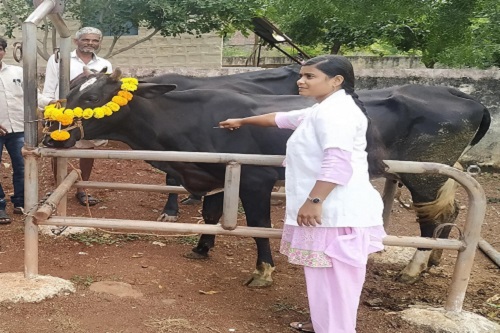
Reference
- Wikipedia
- NDDB, website
| The content of the articles are accurate and true to the best of the author’s knowledge. It is not meant to substitute for diagnosis, prognosis, treatment, prescription, or formal and individualized advice from a veterinary medical professional. Animals exhibiting signs and symptoms of distress should be seen by a veterinarian immediately. |


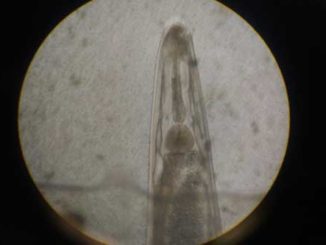
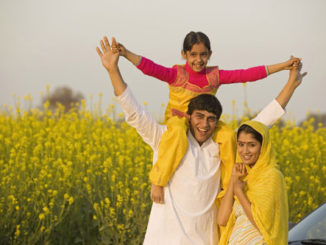
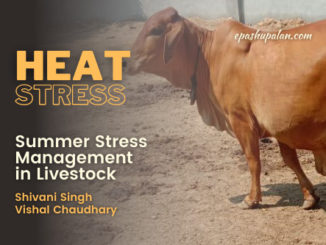

1 Trackback / Pingback